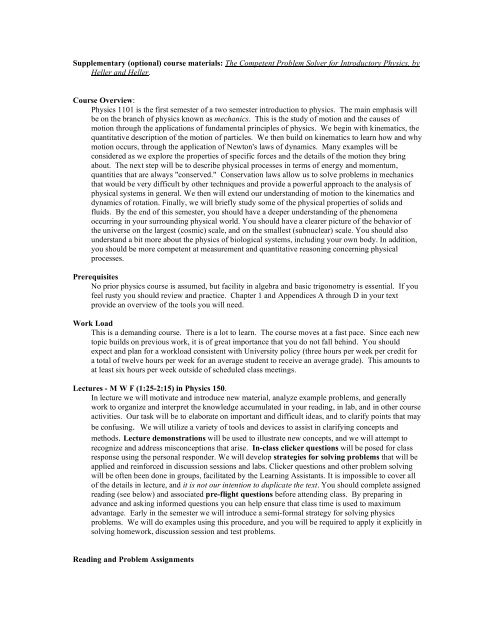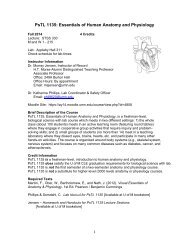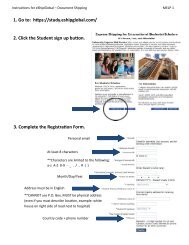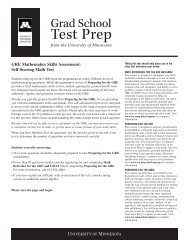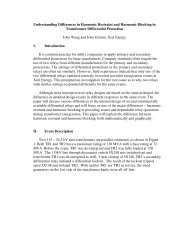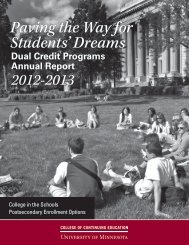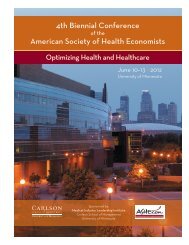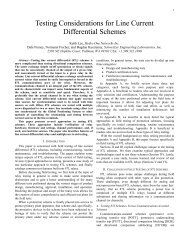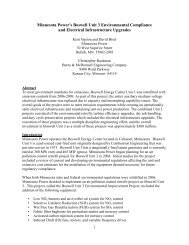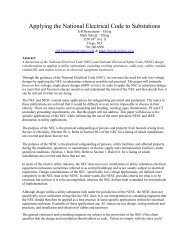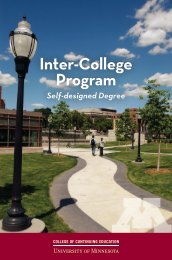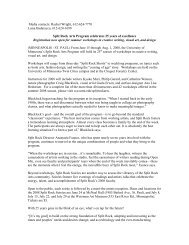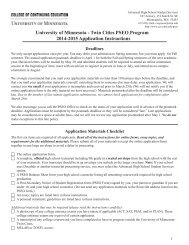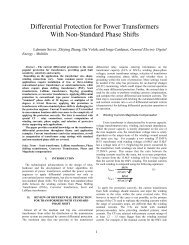Sample syllabus - College of Continuing Education - University of ...
Sample syllabus - College of Continuing Education - University of ...
Sample syllabus - College of Continuing Education - University of ...
You also want an ePaper? Increase the reach of your titles
YUMPU automatically turns print PDFs into web optimized ePapers that Google loves.
Supplementary (optional) course materials: The Competent Problem Solver for Introductory Physics, by<br />
Heller and Heller.<br />
Course Overview:<br />
Physics 1101 is the first semester <strong>of</strong> a two semester introduction to physics. The main emphasis will<br />
be on the branch <strong>of</strong> physics known as mechanics. This is the study <strong>of</strong> motion and the causes <strong>of</strong><br />
motion through the applications <strong>of</strong> fundamental principles <strong>of</strong> physics. We begin with kinematics, the<br />
quantitative description <strong>of</strong> the motion <strong>of</strong> particles. We then build on kinematics to learn how and why<br />
motion occurs, through the application <strong>of</strong> Newton's laws <strong>of</strong> dynamics. Many examples will be<br />
considered as we explore the properties <strong>of</strong> specific forces and the details <strong>of</strong> the motion they bring<br />
about. The next step will be to describe physical processes in terms <strong>of</strong> energy and momentum,<br />
quantities that are always "conserved." Conservation laws allow us to solve problems in mechanics<br />
that would be very difficult by other techniques and provide a powerful approach to the analysis <strong>of</strong><br />
physical systems in general. We then will extend our understanding <strong>of</strong> motion to the kinematics and<br />
dynamics <strong>of</strong> rotation. Finally, we will briefly study some <strong>of</strong> the physical properties <strong>of</strong> solids and<br />
fluids. By the end <strong>of</strong> this semester, you should have a deeper understanding <strong>of</strong> the phenomena<br />
occurring in your surrounding physical world. You should have a clearer picture <strong>of</strong> the behavior <strong>of</strong><br />
the universe on the largest (cosmic) scale, and on the smallest (subnuclear) scale. You should also<br />
understand a bit more about the physics <strong>of</strong> biological systems, including your own body. In addition,<br />
you should be more competent at measurement and quantitative reasoning concerning physical<br />
processes.<br />
Prerequisites<br />
No prior physics course is assumed, but facility in algebra and basic trigonometry is essential. If you<br />
feel rusty you should review and practice. Chapter 1 and Appendices A through D in your text<br />
provide an overview <strong>of</strong> the tools you will need.<br />
Work Load<br />
This is a demanding course. There is a lot to learn. The course moves at a fast pace. Since each new<br />
topic builds on previous work, it is <strong>of</strong> great importance that you do not fall behind. You should<br />
expect and plan for a workload consistent with <strong>University</strong> policy (three hours per week per credit for<br />
a total <strong>of</strong> twelve hours per week for an average student to receive an average grade). This amounts to<br />
at least six hours per week outside <strong>of</strong> scheduled class meetings.<br />
Lectures - M W F (1:25-2:15) in Physics 150.<br />
In lecture we will motivate and introduce new material, analyze example problems, and generally<br />
work to organize and interpret the knowledge accumulated in your reading, in lab, and in other course<br />
activities. Our task will be to elaborate on important and difficult ideas, and to clarify points that may<br />
be confusing. We will utilize a variety <strong>of</strong> tools and devices to assist in clarifying concepts and<br />
methods. Lecture demonstrations will be used to illustrate new concepts, and we will attempt to<br />
recognize and address misconceptions that arise. In-class clicker questions will be posed for class<br />
response using the personal responder. We will develop strategies for solving problems that will be<br />
applied and reinforced in discussion sessions and labs. Clicker questions and other problem solving<br />
will be <strong>of</strong>ten been done in groups, facilitated by the Learning Assistants. It is impossible to cover all<br />
<strong>of</strong> the details in lecture, and it is not our intention to duplicate the text. You should complete assigned<br />
reading (see below) and associated pre-flight questions before attending class. By preparing in<br />
advance and asking informed questions you can help ensure that class time is used to maximum<br />
advantage. Early in the semester we will introduce a semi-formal strategy for solving physics<br />
problems. We will do examples using this procedure, and you will be required to apply it explicitly in<br />
solving homework, discussion session and test problems.<br />
Reading and Problem Assignments


